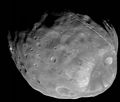קובץ:Phobos colour 2008.jpg

גודל התצוגה המקדימה הזאת: 636 × 600 פיקסלים. רזולוציות אחרות: 255 × 240 פיקסלים | 509 × 480 פיקסלים | 815 × 768 פיקסלים | 1,086 × 1,024 פיקסלים | 2,172 × 2,048 פיקסלים | 3,500 × 3,300 פיקסלים.
לקובץ המקורי (3,500 × 3,300 פיקסלים, גודל הקובץ: 2.72 מ"ב, סוג MIME: image/jpeg)
היסטוריית הקובץ
ניתן ללחוץ על תאריך/שעה כדי לראות את הקובץ כפי שנראה באותו זמן.
| תאריך/שעה | תמונה ממוזערת | ממדים | משתמש | הערה | |
|---|---|---|---|---|---|
| נוכחית | 06:10, 2 באפריל 2018 |  | 3,300 × 3,500 (2.72 מ"ב) | Kaldari | more margin on right side |
| 07:47, 13 בנובמבר 2008 |  | 3,300 × 3,374 (2.7 מ"ב) | Fir0002 | == Summary == {{Information |Description=Colour image of Phobos, imaged by the Mars Reconnaisance Orbiter in 2008 |Source=NASA |Date=9 April 2008 |Location=http://www.nasa.gov/mission_pages/MRO/multimedia/pia10368.html |Author=NASA/J |
שימוש בקובץ
הדף הבא משתמש בקובץ הזה:
שימוש גלובלי בקובץ
אתרי הוויקי השונים הבאים משתמשים בקובץ זה:
- שימוש באתר af.wikipedia.org
- שימוש באתר an.wikipedia.org
- שימוש באתר ar.wikipedia.org
- المريخ
- فوبوس
- قمرا المريخ
- ويكيبيديا:صور مختارة/الفضاء والكون/نظرة إلى الأعلى
- قائمة أجرام المجموعة الشمسية مرتبة حسب الحجم
- بوابة:علم الفلك/صورة مختارة
- بوابة:المريخ
- بوابة:المريخ/مقالة مختارة/أرشيف
- بوابة:المريخ/مقالة مختارة/2
- قائمة الأقمار الطبيعية
- خط زمني لاكتشاف كواكب المجموعة الشمسية وأقمارها
- ويكيبيديا:ترشيحات الصور المختارة/القمر فوبوس
- ويكيبيديا:صورة اليوم المختارة/أغسطس 2019
- قالب:صورة اليوم المختارة/2019-08-03
- بوابة:علم الفلك/صورة مختارة/73
- معسكر قاعدة المريخ
- ويكيبيديا:صورة اليوم المختارة/يناير 2022
- قالب:صورة اليوم المختارة/2022-01-04
- שימוש באתר ary.wikipedia.org
- שימוש באתר arz.wikipedia.org
- שימוש באתר as.wikipedia.org
- שימוש באתר azb.wikipedia.org
- שימוש באתר az.wikipedia.org
- שימוש באתר be-tarask.wikipedia.org
- שימוש באתר be.wikipedia.org
- שימוש באתר bg.wikipedia.org
- שימוש באתר bh.wikipedia.org
- שימוש באתר bn.wikipedia.org
- שימוש באתר bn.wikibooks.org
- שימוש באתר bs.wikipedia.org





